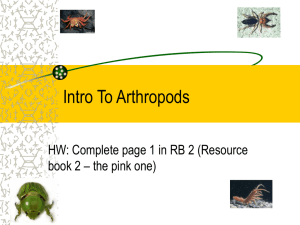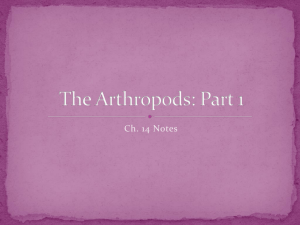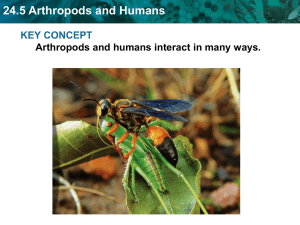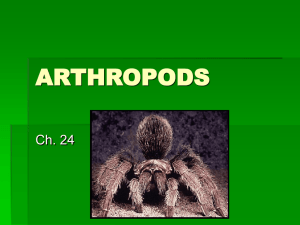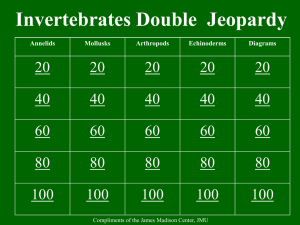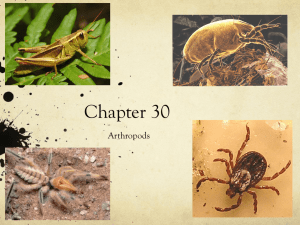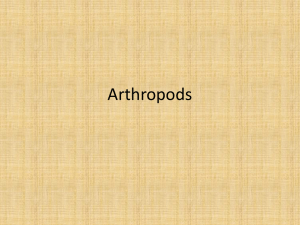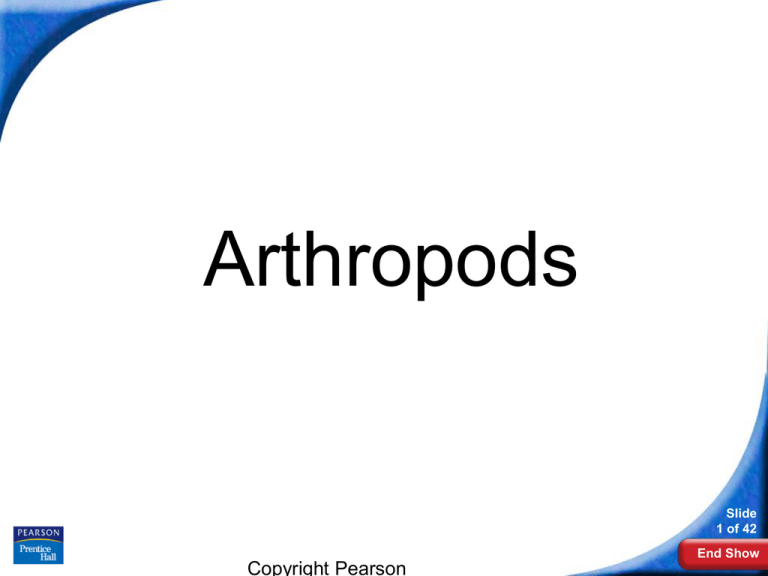
28-1 Introduction to the Arthropods
Arthropods
Slide
1 of 42
End Show
Copyright Pearson
What Is an Arthropod?
What Is an Arthropod?
Arthropods have a segmented body,
a tough exoskeleton, and jointed
appendages.
Arthropods include insects, crabs,
centipedes, and spiders.
Slide
2 of 42
End Show
Copyright Pearson
What Is an Arthropod?
Arthropods are surrounded by a tough
external covering, or exoskeleton.
The exoskeleton is made from protein
and chitin. Chitin is a carbohydrate.
Slide
3 of 42
End Show
Copyright Pearson
What Is an Arthropod?
All arthropods have jointed appendages.
Appendages are structures that extend from
the body wall.
Legs and antennae are appendages.
Slide
4 of 42
End Show
Copyright Pearson
Form and Function in
Arthropods
• Arthropods use complex organ systems to
carry out different essential functions.
• Organ systems are interrelated; the
functioning of one system depends on that
of other systems.
Slide
5 of 42
End Show
Copyright Pearson
Form and Function in
Arthropods
Feeding
• Arthropods include herbivores, carnivores,
and omnivores. There are filter feeders,
detritivores, and parasites.
• The mouthparts of arthropods are adapted
to the type of food the arthropod eats.
Slide
6 of 42
End Show
Copyright Pearson
Form and Function in
Arthropods
Most aquatic arthropods, such as
lobsters and crabs, respire through
featherlike gills.
Horseshoe crabs respire through book
gills.
Slide
7 of 42
End Show
Copyright Pearson
Form and Function in
Arthropods
Circulation
• Arthropods
have an open
circulatory
system.
• The heart
pumps blood
through arteries
that branch and
enter the
tissues.
Heart
Slide
8 of 42
End Show
Copyright Pearson
28–2 Groups of Arthropods
Form and Function in
Arthropods
Excretion
In aquatic arthropods, diffusion
moves wastes from the body into the
surrounding water.
Slide
9 of 42
Copyright Pearson Prentice Hall
End Show
28–2 Groups of Arthropods
Form and Function in
Arthropods
Response
• Most arthropods have a well-developed
nervous system.
• All arthropods have a brain.
• Two nerves connect the brain to a ventral
nerve cord. Along this nerve cord are
several groups of nerve cells called
ganglia.These ganglia coordinate the
movements of individual legs.
Slide
10 of 42
Copyright Pearson Prentice Hall
End Show
28–2 Groups of Arthropods
Form and Function in
Arthropods
Most arthropods have sophisticated sense
organs such as compound eyes.
Compound eyes may have more than 2000
separate lenses and can detect color and
motion very well.
Slide
11 of 42
Copyright Pearson Prentice Hall
End Show
28–2 Groups of Arthropods
Form and Function in
Arthropods
Movement
• Arthropods move using well-developed
groups of muscles that are coordinated and
controlled by the nervous system.
• Muscles generate force by contracting and
then pulling on the exoskeleton.
Slide
12 of 42
Copyright Pearson Prentice Hall
End Show
28–2 Groups of Arthropods
Form and Function in
Arthropods
Reproduction
• In some species, males deposit sperm inside
females.
• In other species, the males deposit a sperm
packet that is picked up by the females.
• Aquatic arthropods may have internal or
external fertilization.
Slide
13 of 42
Copyright Pearson Prentice Hall
End Show
28–2 Groups of
Arthropods
Slide
14 of 42
Copyright Pearson Prentice Hall
End Show
28–2 Groups of Arthropods
28–2 Groups of Arthropods
Arthropods are classified based on the
number and structure of their body
segments and appendages—particularly
their mouthparts.
The three major groups of arthropods are:
• crustaceans
• spiders and their relatives
• insects and their relatives
Slide
15 of 42
Copyright Pearson Prentice Hall
End Show
28–2 Groups of Arthropods
Crustaceans
What are the distinguishing features of
the crustaceans?
Slide
16 of 42
Copyright Pearson Prentice Hall
End Show
28–2 Groups of Arthropods
Crustaceans
Crustaceans
Crustaceans are primarily aquatic.
This subphylum includes crabs, shrimps,
lobsters, crayfishes, and barnacles.
Slide
17 of 42
Copyright Pearson Prentice Hall
End Show
28–2 Groups of Arthropods
Crustaceans
Crustaceans typically have two pairs of
antennae, two or three body sections, and
chewing mouthparts called mandibles.
Abdomen
Cephalothorax
Mandible
First antenna
Second antenna
Slide
18 of 42
Copyright Pearson Prentice Hall
End Show
28–2 Groups of Arthropods
Crustaceans
The crayfish has a body plan that is typical of many
crustaceans.
The anterior cephalothorax is formed by fusion of
the head with the thorax.
Cephalothorax
Slide
19 of 42
Copyright Pearson Prentice Hall
End Show
28–2 Groups of Arthropods
Crustaceans
The thorax lies just behind the head and houses
most of the internal organs.
Slide
20 of 42
Copyright Pearson Prentice Hall
End Show
28–2 Groups of Arthropods
Crustaceans
The abdomen is the posterior part of the body.
Abdomen
Slide
21 of 42
Copyright Pearson Prentice Hall
End Show
28–2 Groups of Arthropods
Crustaceans
The carapace is the part of the exoskeleton that
covers the cephalothorax.
Carapace
Slide
22 of 42
Copyright Pearson Prentice Hall
End Show
28–2 Groups of Arthropods
Crustaceans
In a crustacean, the first two pairs of appendages are
antennae.
First antenna
Second
antenna
Slide
23 of 42
Copyright Pearson Prentice Hall
End Show
28–2 Groups of Arthropods
Crustaceans
The third pair of appendages are the mandibles.
A mandible is a mouthpart adapted for biting and
grinding food.
Mandible
Slide
24 of 42
Copyright Pearson Prentice Hall
End Show
28–2 Groups of Arthropods
Crustaceans
Decapods have five pairs of legs.
In crayfishes, the first pair of legs, called chelipeds,
have large claws that catch, pick up, crush, and cut
food.
Walking legs
Copyright Pearson Prentice Hall
Cheliped
Slide
25 of 42
End Show
28–2 Groups of Arthropods
Crustaceans
Behind these legs are four pairs of walking legs.
Walking legs
Copyright Pearson Prentice Hall
Cheliped
Slide
26 of 42
End Show
28–2 Groups of Arthropods
Crustaceans
Along the abdomen are several pairs of
swimmerets, which are flipperlike appendages used
for swimming.
Swimmerets
Slide
27 of 42
Copyright Pearson Prentice Hall
End Show
28–2 Groups of Arthropods
Crustaceans
The final abdominal segment is fused with a pair of
paddlelike appendages to form a large, flat tail.
Tail
Slide
28 of 42
Copyright Pearson Prentice Hall
End Show
28–2 Groups of Arthropods
Spiders and Their Relatives
What are the distinguishing features of
spiders and their relatives?
Slide
29 of 42
Copyright Pearson Prentice Hall
End Show
28–2 Groups of Arthropods
Spiders and Their Relatives
Spiders and Their Relatives
Horseshoe crabs, spiders, ticks, and scorpions
are chelicerates.
Chelicerates lack antennae.
Slide
30 of 42
Copyright Pearson Prentice Hall
End Show
28–2 Groups of Arthropods
Spiders and Their Relatives
Chelicerates have mouthparts called
chelicerae and two body sections, and
nearly all have four pairs of walking legs.
Fanglike
chelicera
Copyright Pearson Prentice Hall
Slide
31 of 42
End Show
28–2 Groups of Arthropods
Spiders and Their Relatives
Chelicerates have two pairs of appendages attached
near the mouth that are adapted as mouthparts.
Fanglike
chelicera
Copyright Pearson Prentice Hall
Slide
32 of 42
End Show
28–2 Groups of Arthropods
Spiders and Their Relatives
Chelicerae contain fangs and are used to stab and
paralyze prey.
Fanglike
chelicera
Copyright Pearson Prentice Hall
Slide
33 of 42
End Show
28–2 Groups of Arthropods
Spiders and Their Relatives
Pedipalps are longer than the chelicerae and are
usually modified to grab prey.
Pedipalp
Slide
34 of 42
Copyright Pearson Prentice Hall
End Show
28–2 Groups of Arthropods
Spiders and Their Relatives
Chelicerates are divided into three main classes.
• Merostomata includes horseshoe crabs.
• Pycnogonida includes sea spiders.
• Arachnida, or arachnids, includes spiders, mites,
ticks, and scorpions.
Horseshoe crabs and sea spiders are both marine
organisms.
Slide
35 of 42
Copyright Pearson Prentice Hall
End Show
28–2 Groups of Arthropods
Spiders and Their Relatives
Horseshoe Crabs
Horseshoe crabs are found in shallow water on soft
sandy or muddy bottoms. There has been a decline in
number of individuals, as a consequence of coastal
habitat destruction and pollution.
They have chelicerae, five pairs of walking legs, and a
long spikelike tail that is used for movement. While they
can swim upside down, they usually are found on the
ocean floor searching for worms and molluscs, which
are their main food. They may also feed on crustaceans
and even small fish.
Slide
36 of 42
Copyright Pearson Prentice Hall
End Show
28–2 Groups of Arthropods
Horseshoe crab
Slide
37 of 42
Copyright Pearson Prentice Hall
End Show
28–2 Groups of Arthropods
Horseshoe crab
Slide
38 of 42
Copyright Pearson Prentice Hall
End Show
28–2 Groups of Arthropods
Spiders and Their Relatives
Sea Spiders
Sea spiders have long legs in contrast to a small
body size.
The number of walking legs is usually eight (four
pairs), but species with five and six pairs exist.
Because of their small size and slender body and
legs, no respiratory system is necessary, with gases
moving by diffusion.
A proboscis allows them to suck nutrients from softbodied invertebrates, and their digestive tract has
diverticula extending into the legs.
Slide
39 of 42
Copyright Pearson Prentice Hall
End Show
28–2 Groups of Arthropods
Sea spider
Slide
40 of 42
Copyright Pearson Prentice Hall
End Show
28–2
The two main groups of chelicerates are
a. spiders and scorpions.
b. horseshoe crabs and spiders.
c. horseshoe crabs and arachnids.
d. arachnids and insects.
Slide
41 of 42
End Show
Copyright Pearson Prentice Hall
28–2
Insects are part of the group
a. crustaceans.
b. uniramians.
c. chelicerates.
d. diplopods.
Slide
42 of 42
End Show
Copyright Pearson Prentice Hall
28–2
Most mites and ticks are
a. parasites.
b. predators.
c. herbivores.
d. detritovores.
Slide
43 of 42
End Show
Copyright Pearson Prentice Hall
28–2
Which of the following is NOT a typical
crustacean characteristic?
a. either two or three body segments
b. chewing mouthparts called mandibles
c. chelicerae that paralyze prey
d. two pairs of antennae
Slide
44 of 42
End Show
Copyright Pearson Prentice Hall
28–2
Spiders differ from the other arachnids because
they have
a. two major body segments and six legs.
b. three major body segments and eight legs.
c. two major body segments and eight legs.
d. three major body segments and six legs.
Slide
45 of 42
End Show
Copyright Pearson Prentice Hall
END OF SECTION

